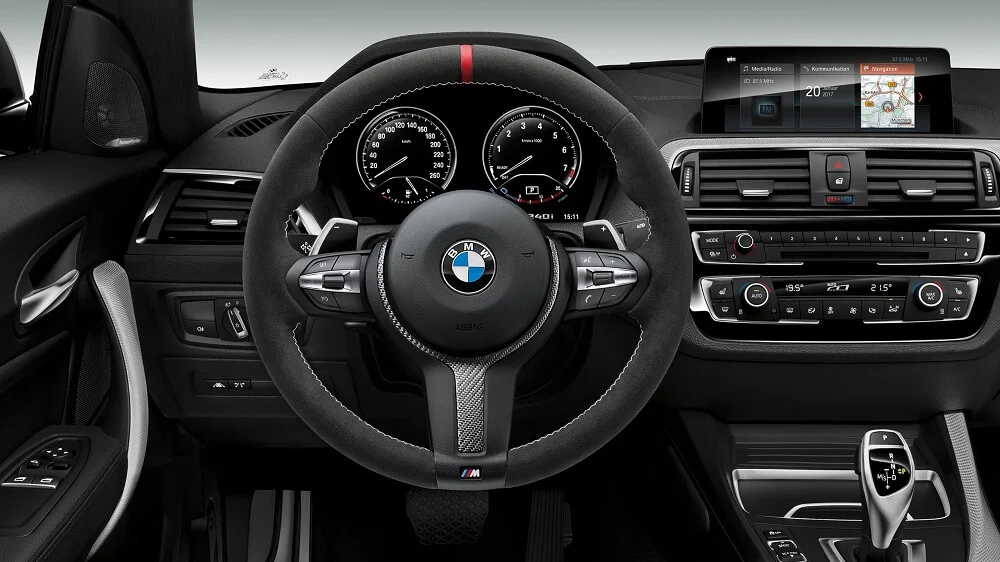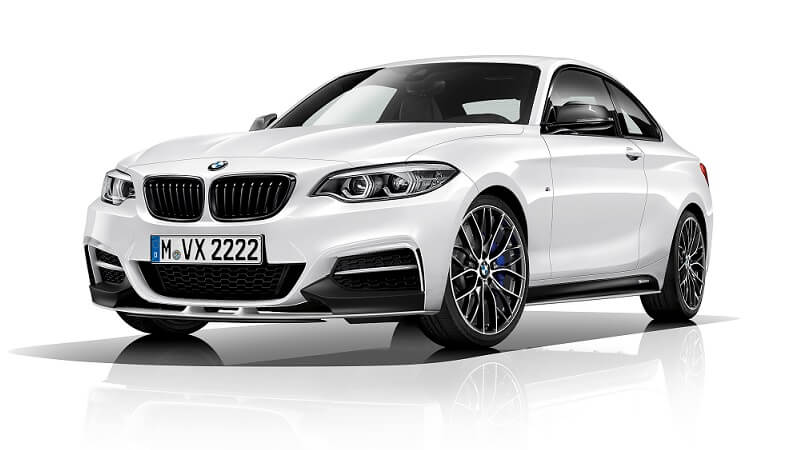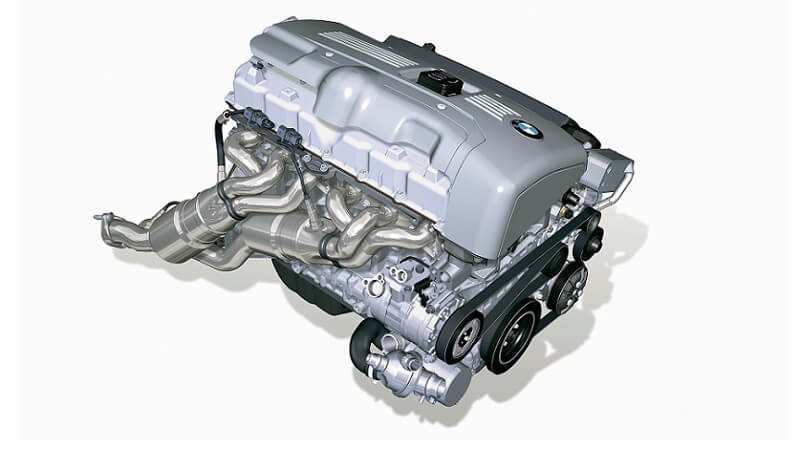For 2014, BMW decided to spin off the two-door models — coupé and convertible — of the BMW 1 Series into a separate series. This was the birth of the BMW 2 Series we know today, and the first generation of these cars was the BMW F22.
Almost immediately, the 2-Series became one of Bavaria’s greats and established itself as a proper driver’s car. It was one of those cars whose ethos was similar to the machines from yesteryear that had made BMW the automotive giant it is today.

The Rebirth of a Compact Sports Coupe
In the late 1960s, Helmut Werner Bönsch, BMW’s director of product planning, and Alex von Falkenhausen, the man behind the M10 engine, had a two-liter engine installed onto their respective 1600-2 cars. When they realized that they’d made the same update to their cars, they pitched the idea to BMW’s board and asked them to create a sportier version of the 02 Series. The result was the BMW 2002, which is perhaps the manufacturer’s very first sports coupe from a time when the term didn’t even exist.
Shortly after the 2002 was revealed, BMW upgraded it with a “ti” (Touring International) suffix that brought more performance and better handling. In 1973, BMW took the wraps off the 2002 Turbo, its first turbocharged production car, producing an impressive 170 hp and 177 lb-ft of torque. These cars were lightweight, agile, and fast while still being practical and comfortable.
Today’s BMW 2-Series exemplifies this line of cars and does a spectacular job honoring its ancestors.
BMW F22 2-Series – The New Kid on the Block
Like we mentioned above, the 2 Series is the replacement for the 1 Series, which until the former came about played the role of being the smallest BMW and spiritual successor to the 2002. The F22 2-Series was slightly larger than the E82 1-Series it replaced.
It was longer and broader, which resulted in more headroom and extra space in the trunk. The added dimensions also meant that it was heavier than the car it was replacing. However, despite the excess weight, the 2-Series was still as exciting, and a 50:50 weight distribution with a ride height that sat 5 mm closer to the ground resulted in a superbly balanced machine.
Body Styles
The first-generation of the 2-Series is available in two body styles — a coupé and a convertible. The former is called the F22, while the latter is called the F23. However, the two body styles are collectively referred to as the F22 2-Series. The United States was its largest market, with nearly one-third of all F22 cars being sold here.
Available Powertrain Options
The F22 was available with multiple engine options over its lifetime, but not all have made their way to the U.S. market. When launched over here in 2014, two models were available — the base 228i and the performance-spec M235i. In Europe, there was also a three-pot 218i and a detuned version of the 228i called the 220i.
Only three models of the F22 were powered by a diesel engine. However, none of these made their way to the North American market. If you’re reading this from Europe or one of the other markets that BMW sold the 218d, 220d, and 225d in, here’s what they had to offer:

Petrol:
- 2015-present 1.5L inline-three turbo B38A15M0 in 218i, producing 134 hp at 4,500–6,000 rpm and 162 lb-ft of torque at 1,250 rpm (Not sold in the U.S.)
- 2014–2016 2.0L inline-four turbo N20B20 in 220i, producing 181 hp at 5,000–6,250 rpm and 199 lb-ft of torque at 1,250–4,500 rpm. (Not sold in the U.S.)
- 2016-present 2.0L inline-four turbo B48B20 in 220i, producing 181 hp at 5,000–6,250 rpm and 214 lb-ft of torque at 1,250–4,500 rpm.
- 2014-2016 2.0L inline-four turbo N20B20 in 228i, producing 241 hp at 5,000–6,500 rpm and 258 lb-ft of torque at 1,250–4,800 rpm.
- 2016-2021 2.0L inline-four turbo B48B20 in 230, producing 248 hp at 5,200 rpm and 258 lb-ft of torque at 1,450–4,800 rpm.
- 2014-2016 3.0L inline-six turbo N55B30O0 in M235i, producing 322 hp at 5,800–6,000 rpm and 332 lb-ft of torque at 1,300–4,500 rpm.
- 2016-present 3.0L inline-six turbo B58B30O0 in M240i/M240i xDrive, producing 335 hp at 5,500 rpm and 369 lb-ft of torque at 1,520–4,500 rpm.
- 2015–2018 3.0L inline-six turbo N55B30T0 in M2, producing 365 hp at 6,500 rpm and 343 lb-ft of torque at 1,450–4,750 rpm.
- 2018-present 3.0L inline-six twin-turbo S55 in M2 Competition, producing 405 hp at 5,370–7,200 rpm and 406 lb-ft of torque at 2,350–5,230 rpm.
- 2020 3.0L inline-six twin-turbo S55 in M2 CS, producing 444 hp at 6,250 rpm and 406 lb-ft of torque at 2,350–5,500 rpm.
Diesel
- 2014–2015 2.0L inline-four turbo N47D20O1 in 218d, producing 141 hp at 4,000 rpm and 236 lb-ft of torque at 1,750–2,500 rpm.
- 2015–present 2.0L inline-four turbo B47D20 in 218d, producing 148 hp at 4,000 rpm and 236 lb-ft of torque at 1,500–3,000 rpm.
- 2014–2015 2.0L inline-four turbo N47D20O1 in 220d, producing 181 hp at 4,000 rpm and 280 lb-ft of torque at 1,750–2,750 rpm.
- 2015-present 2.0L inline-four turbo B47D20 in 220d, producing 188 hp at 4,000 rpm and 295 lb-ft of torque at 1,750–2,500 rpm.
- 2014–2015 2.0L inline-four twin-turbo N47D20T1, producing 215 hp at 4,400 rpm and 332 lb-ft of torque at 1,500–2,500 rpm.
- 2015-2019 2.0L inline-four twin-turbo B47D20, producing 221 hp at 4,400 rpm and 332 lb-ft of torque at 1,500–3,000 rpm.
Performance
The BMW F22 2-Series is a fast car. Even the base 228i was capable of a sub 6 second 0-60 mph time; the convertible managed the sprint in 5.7 seconds, while the hard-top coupe got there 0.2s quicker. The 230i that came after was capable of similar performance and got to 60mph 0.1s quicker, on average than its 228i counterpart.

The M235i and M240i with their straight-six engines were notably quicker. The M235i took 4.8s to get to 60mph, while the M240i did it in 4.6s. With xDrive, the latter was even faster, getting there in just 4.4 seconds.
The fastest of the lot was, unsurprisingly, the M2, with a 0-60mph time of 4.3s. Its successors, the M2 Competition and M2 CS shaved a couple of milliseconds of that time, achieving the feat at 4.2s and 4.0s, respectively.
Transmission Options
The 228i coupe, M235i coupe, and M235i convertible are all available with either a six-speed manual or eight-speed automatic in the U.S. market. Meanwhile, the 228i convertible, 228i xDrive, and M235i xDrive models only come with the eight-speed auto option.
On the other hand, the M2 is available with either a six-speed manual or a dual-clutch seven-speed automatic.
BMW F22 Chassis Through the Years
Over its lifespan, BMW updated the F22 a couple of times, but the most significant changes came in 2016. The B48 replaced the N20 engine, and the higher-performance N55 gave way to the B58, bringing about a slight improvement in performance. The engine updates also resulted in newer model names — the 230i took the place of the 228i is the base model, while the M240i replaced the M235i.

The year 2016 was also when the M2 made its debut. Other upgrades introduced across the 2-Series included the addition of xDrive, BMW’s all-wheel-drive system, and updates to the iDrive system.
BMW introduced some minor revisions for the following model year, including new headlights and tweaks to the alloy wheel design and paint scheme.
Optional Packages
All BMW F22 models came with a comprehensive list of equipment as standard, including automatic climate control and a 6.5-inch display with iDrive. Additionally, owners could equip the car with optional packages that include different features and accessories.
Cold Weather Package
For about $700, buyers of the F22 2-Series could equip their car with the Cold Weather Package that included retractable headlight washers, heated front seats, and a heated steering wheel.
Driver Assistance Package
This package offered a rearview camera and Park Distance Control, costing $950.
Driver Assistance Plus
In addition to what the base Driver Assistance Package offers, this one came with automatic high beams, speed limit info, and an Active Driving Assistant. It costs an extra $700 over what you’d pay for the base package.
Lighting Package
For around $900, the Lighting Package included Xenon headlights and adaptive light control.
Track Handling Package
This was one of the more substantial packages available for the F22 and sat a step below the M Sport Package. It included 18-inch wheels, M Sport brakes, adaptive M suspension, and variable sport steering for a total of $2,300.
M Sport Package
The M Sport Package cost around $2,500 and included what the Track Handling Package had to offer, in addition to tweaks to the exterior, including an aerodynamic kit and rear spoiler.
Luxury Package
The Luxury Package included an upscale wood trim on the interior and a Harmon Kardon sound system.
Premium Package
The last of the packages available for the F22 offered a moon roof, automatic-dimming rearview mirrors, lumbar support on the seats, and ambient lighting.
BMW F22 M2
The F22 M2 was all the standard car had to offer and more. It was powered by the more powerful N55 inline-six turbocharged engine, while its successors featured the even more potent S55 with a twin-turbo setup.
Compared to the standard car, changes included sport-oriented suspension, steering, and braking systems; aerodynamic modifications to the exterior, and updates to the interior with ‘M’ elements like a lighter, more responsive steering wheel and more focussed seats.
For 2019, the M2 was replaced by the M2 Competition. Apart from the added performance, the M2 Competition also offered a carbon-fiber-reinforced plastic strut bar, larger kidney grilles, and higher-spec brakes.
The BMW M2 CS, which debuted in 2020, was a track-focused version of the BMW M2. Only about 560 units of this car made it to the U.S., so they’re incredibly rare, and you’re unlikely to come by one in the used-car market.
Is the BMW F22 reliable?

You’ll find little reason to complain about reliability if you own a BMW F22. If you’re looking at the 228i, you may be concerned about the N20 engine that did have a reputation for being hard to maintain. However, this was prevalent only in earlier iterations of the engine, and by the time it made its way onto the F22, BMW resolved most of these issues.
Meanwhile, the 230i is powered by the B48, one of BMW’s most recent engines, and even the oldest of these on an F22 is less than six years old. They’re solidly built engines, based on the foundation that is the N20.
The higher performance N55 and B58 engines are well put together as well, and you won’t find yourself running into any major issues as long as you run regular maintenance checks.
BMW F22 Common Problems

As we just mentioned, the F22 is a reliable machine for the most part. Plus, considering that even the oldest examples of one out there are less than eight years old, it’s unlikely they’re heavily run, and you won’t have much to worry about. That said, some issues commonly affect the engines on these cars, and you should check for them if you’re looking to buy one.
N20 Timing Chain Issue
Thousands of early-production engines were affected by a notorious timing chain issue. The timing chains were made of a substandard polymer timing chain guide on these engines. This caused them to break and resulted in severe damage to the engine.
This isn’t a matter of grave concern with the F22 as BMW soon realized that something was wrong and made changes to the manufacturing process. It also offered an extended 7-year/70,000-mile warranty on the timing chain and its parts on the vehicles produced before 2015. If you’re buying a pre-2015 BMW F22, it’s worth looking into whether the previous owner experienced any issues with the timing chain and if they’ve had it replaced with the newer part.
If not, you might be better off looking at other options as the timing chain will cost you. It’ll set you back even more if it’s already caused extensive damage to the engine.
The easiest way to spot a faulty timing chain is to have it looked at by a technician. If this isn’t an option, check for a whining noise from the engine. Inspecting the timing chain visually and looking for excess slack or scratching could also indicate a faulty unit. Keep in mind that these symptoms are shared with any timing chain that’s run its course and needs replacement.
Valve Cover and Valve Cover Gasket
Most modern-day BMW engines, including those powering the F22, use a rubber valve cover gasket and a plastic composite valve cover. Given the construction materials used, these parts are subject to wear out and crack under the high-temperature environment that they function in.
If you spot leaked oil on the left side of your engine, it could mean that the valve cover or gasket has failed or cracked. Oil dripping onto the exhaust or some other high-temperature part of the engine bay will result in thick white smoke, and this is another way of telling if there’s an oil leak. If you do see this, there’s no reason to panic.
An oil leak is typically a minor issue, and replacing the gasket or cover should solve the problem. However, if you leave it unattended, it could result in premature wear of other components in the engine that are deprived of oil, and that’s a problem you want to avoid.
Oil Filter Housing Gasket
If you see some of the symptoms we just mentioned with the valve cover and valve cover gasket, it could also result from a worn-out oil filter housing gasket. It’s another rubber component that is subject to wear and tear by the heat from the engine.
The oil filter housing itself might also crack over time, but this is a much less likely scenario when compared to the gasket. Replacing the latter is relatively inexpensive, but the housing will cost you a couple of hundred dollars, at the very least.
VANOS Solenoid Failure
This issue is most prevalent on the turbocharged BMW inline-six engines, like the N55 and B58. VANOS is BMW’s variable valve timing technology, and a key component in its functioning is solenoids. These VANOS solenoids are at work every time the engine is running, and, understandably, they will wear out in time.
If the engine is poorly maintained, these solenoids can develop a coating of oil that can result in further complications, like a significant drop in performance or sending your car into limp mode.
Crank Hub Issues
One of the more severe but, luckily, rarely reported issues with the N55 and its high-performance iteration, the S55, is to do with the crank hub. A handful of owners have experienced a spun crank hub which can cause some significant engine problems, most of which you’ll be able to spot — it will affect engine timing, send your car into limp mode, and light up the engine malfunction light on the dash.
Oil Pan Gasket Leak
The oil pan gasket on the N55 and S55 is another component that tends to cause issues. Like with the oil filter and valve cover gaskets we looked at above, this part too is prone to breaking from being in a high-temperature environment. Most modern-day BMW engines should get past the 100,000-mile mark on the factory-installed gasket, but some N55 and S55 owners have reported failure much sooner.
While the part itself is inexpensive, getting to it is labor-intensive, and this will contribute to a majority of your service bill.
Which BMW F22 to Get?
The BMW F22 2-Series is, by far, one of the best examples of a BMW that you can buy today. Even the base 228i or 230i is an excellent option for someone looking for a great daily driver that’s still fun.
If you have a little more money to spend, the inline-six M235i and M240i come with notably more performance and offer arguably all the car you’ll ever need. If money is no object, though, we certainly recommend that you look for an M2. Some regard it as a better driver’s car than the more powerful, better-equipped M3 and M4 models, and we can see why.





